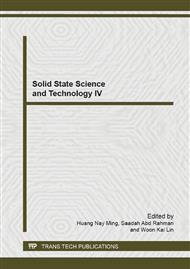p.338
p.343
p.347
p.351
p.355
p.359
p.363
p.375
p.385
The Effect of Fe and Al Substitution in LiNi0.8Co0.2O2 Cathode Material
Abstract:
The effect of different cation substitution on the electrochemical performance of layered LiNi0.8-xCo0.2MxO2 (M= Fe, Al; x=0.1) cathode materials were investigated. LiNi0.8-xCo0.2MxO2 (M= Fe, Al; x=0.1) cathode materials were successfully synthesized by a combustion method with an annealing temperature of 800 °C for 24h. The physical and electrochemical properties of the materials were examined using X-ray Diffractometer (XRD), Field Emission Scanning Electron Microscopy (FESEM) and electrochemical charge-discharge. The XRD data showed that all the materials are single phase, hexagonal α-NaFeO2 type structure. The initial discharge capacity showed that Fe and Al substituted materials gave 8 % and 10 % improvement compared to LiNi0.8Co0.2O2 material. The discharge cycling also showed that the cycle stability has improved when Fe and Al was substituted. In view of electrochemical performance, Al containing sample was found to be superior to those of LiNi0.8Co0.2O2 and Fe substituted cathode materials.
Info:
Periodical:
Pages:
355-358
Citation:
Online since:
February 2014
Keywords:
Price:
Сopyright:
© 2014 Trans Tech Publications Ltd. All Rights Reserved
Share:
Citation:


